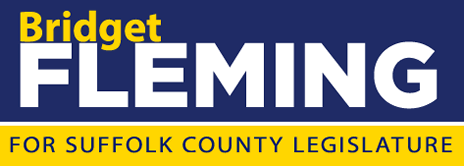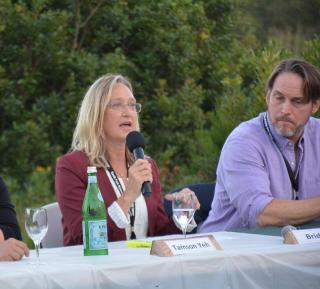With a steady procession of Atlantic hurricanes on everyone’s mind, the South Fork Natural History Museum held its third annual climate change symposium on Saturday. An eight-member panel made up of elected officials and policy makers were of like mind — that climate climate change is both real and serious and requires changes in the way Americans approach their everyday lives.
“I think everybody has a social responsibilty to care about climate change,” said Assemblyman Fred W. Thiele Jr., the evening’s moderator. “We all need to be part of the solution because we are all part of the problem.”
Predictably, panelists called for the usual round of clean energy solutions, from supporting increased wind and solar power power to the recognition that the days of fossil-fuel powered automobiles are probably numbered, but they also made it clear that the issue is no longer one that is of concern to the Democrats and others on the left side of the American political spectrum.
Rod Richardson, the president of the Grace Richardson Foundation, which advocates for free market solutions to policy issues, said he has been focusing the idea of “clean tax cuts to encourage investment in environmentally friendly initiatives. “There has been a massive economic shift” making such investment profitable.“If you want more of something, tax it less,” he said, suggesting the creation of tax-emempt “green bonds” as one solution to encourage more investment.
Most policies now in place assume green industries such as solar power cannot be profitable, he said, and subsidies and other price supports were “the rope laddder” that allowed such businesses to get a footing, they now “become the noose” that prevents the free market from embracing them, he said.
Peter Boyd, the founder and CEO of Time4Good and a fellow at Yale University’s Center for Business and the Environment, echoed Mr. Richardson. Clean energy is getting cheaper and fossil fuels are getting more expensive. “It’s not an if, it’s a when,” he said of the pending shift in the world’s economy.
He added that more and more scientists are sounding the alarm about the stress being placed on the planet. “We don’t know the route, but the destination has been set,” he said of the need to change course. “The turning point has to be sooner than we thought.”
Mr. Boyd said President Trump had missed an opportunity by announcing the United States was pulling out of the Paris climate accord,” in which world nations agreed to a framework for controlling the emission of greenhouse gases. He said the decision risked putting the United States at an economic disadvantage.
To that point, Mr. Thiele said that New York is among 14 states that have pledged to support the Paris agreement, a sign that there is suppoort for its goals.
Mr. Thiele added he supported most of New York State’s energy goals, including the effort to increase wind power through developments like Deepwater Winds South Fork Wind Farm. “We were against nuclear, we were agaisnt natural gas. Those were good things to be against,” he said, “but sometimes you have to be for something.” But the assemblyman said he was opposed to a state plan to require state ratepayers to subsidize four aging nuclear plants in the state. “To me this is an insult. We had to pay money to keep a nuclear plant closed,” he said referring to the never-opened Shoreham plant. “Now we have to pay money to keep a nuclear plant open.”
Michael Gerrard, the director of the Sabin Center for Climate Change Law at Columbia University, cited the active hurricane season. Climate change does not create hurricanes, he said, but hurricanes are made worse by it because climate change results in warming ocean waters, which, in turn lead to stronger storms. “It’s only going to get worse until we get a handle on greenhouse gas,” he said. To do that, the country needs to “decarbonize” its electricity supply by migrating away from conventional power sources,” he said.
County Legislator Bridget Fleming tied climate change to other environmental initiatives, such as the county’s effort to reduce the amount of nitrogen entering ground and surface waters. “We are watching an increasing erosion of our land and our marshes” from development and degradation, she said, while adding those ecosystems provide a first line of defense against rising sea levels.
Another panelist, Assembyman Steve Engelbright, called cimate change the most important issue facing government, and said as sea levels rise, groundwater levels on Long Island will rise, leading to more flooding and peristent problems for homeowners as simple as wet basements.
Tamson Yeh, a turf and land management specialist at Cornell Cooperative Extension, said the effects of climate change are being felt on lawns and gardens, where rising temperatures haver resulted in the region moving up to a warner growing zone. Warmth and drought have helped establish the lone star tick on Long Island, she said. She urged homeowners to eliminate pavers and plant more trees as a simple ways to reduce the amount of heat that is reflected back into the atmosphere.

